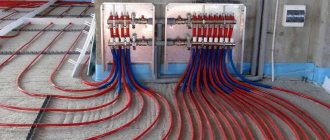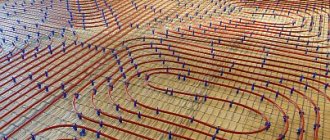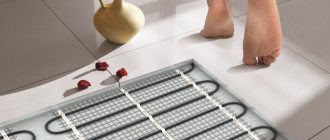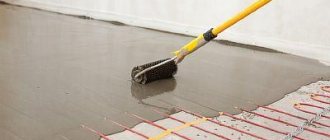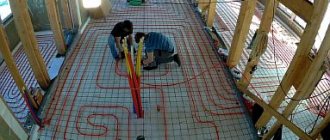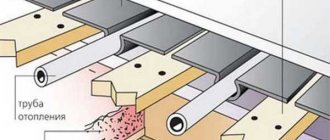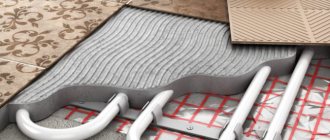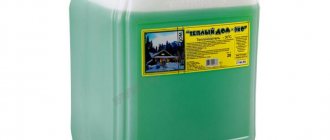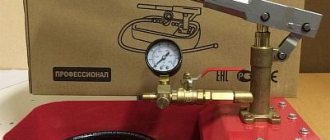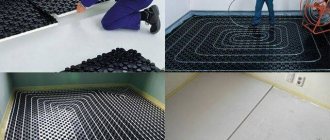Hello, friends. Customers often ask questions related to heating with water heated floors (WHP). The quantity and quality of these questions allowed me to form a whole list of misconceptions. It is unfortunate to note that many heating system design engineers are just as susceptible to these misconceptions, let alone simple self-builders.
These are the misconceptions and questions:
- A water-heated floor in a house cannot cope with heating.
- Warm floors are harmful to health.
- Warm floors cannot be more economical than radiators.
- In small rooms there are only radiators.
- The warm floor is dusty.
- A warm water floor dries the air.
- High price of water heated floor.
- There is no need to install warm floors under the furniture.
- What diameter and laying pitch should I choose?
- What thickness of screed is needed?
- What program can I use to calculate the laying pattern?
- What to do if the water heated floor breaks?
- Which coating with VTP should I use?
- How to make an HTP in an apartment building?
- How to insulate interfloor ceilings?
Let's figure it out together.
A water-heated floor without radiators will not cope with heating
This misconception goes back to the past, when windows were made of wood, and little attention was paid to insulating walls, attics and basements.
In such conditions, attempts to keep up with fashion naturally led to disappointment. That is, floor heating without taking into account the heat losses of the building will lead to failure.
Modern building codes and materials have reduced heat loss to an acceptable 50-70 W/m2 of house area. The coldest five-day period in a given area is taken as the starting point.
Thus, a well-insulated building can be heated exclusively by high-pressure heat sources, even beyond the Arctic Circle.
Video where a house is heated only with heated floors at an outside temperature of -40 °C.
Harm to health from warm water floors
This myth also has a basis. The surface underfoot, which exceeds the temperature of the human body, in the long term will provoke varicose veins, as well as a lot of negative consequences.
But who will let him warm up like that in an insulated house?
The set of rules SP 60.13330.2012 “Heating, ventilation and air conditioning” regulates surface heating to 26 °C.
European standards are softer, they allow heating up to 28 °C.
These standards are valid for premises with permanent occupancy. Utility rooms and bathrooms allow heating up to 31 °C.
The fact is that 50-70 W/m2 per meter of area, with the correct installation spacing and pipe diameter, is the maximum 28 °C.
Why is underfloor heating more economical compared to radiators?
It would seem that we are heating a room of one area, where will the savings of 15-20% come from?
It's all about heat flow distribution. The radiator system is usually heated to 55-75 degrees. The heat flow is aimed at cutting off the cold coming from the windows. Convection created by the radiator lifts hot air to the ceiling, and as the air cools, it sinks to the floor. The effect is especially noticeable where the height of the room exceeds 4 meters; the temperature difference at the bottom and under the ceiling can reach 10 degrees. If people flew, such heating would look natural.
Now let's look at what happens to the floor. Its temperature of 24-28 degrees is evenly distributed over the surface. Convection is weak and the main heat transfer occurs due to infrared radiation (not to be confused with radiation). The legs perceive the most energy; already at chest level the temperature is slightly lower. “Keep your feet warm and your head cold”
Simply put, VTP heats the space that is necessary for a person and nothing extra.
Ceramic tile
Second rule
All areas with ceramic tiles must be heated.
This is due to the high thermal conductivity of the tile itself. If you put your hand on any board in your apartment, it will seem a little warm to you.
And if you place your palm against the metal door of a refrigerator or an unheated oven, you will feel a certain coolness.
However, their temperature will be absolutely the same - room temperature. Iron things always seem much cooler because they have higher thermal conductivity. That is, they transfer their temperature to your hand faster.
Thus, we exchange temperature with any object we come into contact with. However, you can warm up small objects and things - watches, clothes, a chain with your body, but you will never be able to warm up a layer of concrete with tiles.
On the one hand, the coolness from ceramic tiles seems slightly pleasant, but it all ends in illness.
Another important point is the following. Tiles are mainly laid not because they will last a long time, but because of their moisture resistance.
For example, it is placed in the hallway. Come in from the street with wet shoes and immediately put them on the tiles.
It's hard to imagine a bathroom without tiles on the floor. At the same time, you can safely spill water in it, without fear of subsequent swelling of this floor.
However, after you spill this water, you still have to clean it up. And in order to dry the bathroom, it is not enough to simply turn on the exhaust fan.
It also needs to be warmed up so that over time mold fungus does not grow on the walls.
Therefore, if you want to maintain your health and also use your finished floor for a long time without repairing it, be sure to think about forced heating.
Bedrooms should be heated only with radiators
“Experts” claim that furniture, namely sleeping places, interferes with underfloor heating and it is necessary to use radiator systems.
This myth is more difficult for me to explain than others, but I will try to dispel it from personal experience .
Few people, when building a private house, will make bedrooms or offices smaller than 12-15 m2. This area is quite enough to heat the room. Unless of course the windows in the room are French. As we know, the main heat losses of a house occur through windows.
Storerooms and utility rooms usually have small windows, resulting in low heat losses. The temperature requirements there are also low.
The only place in the house where my wife complains about heating with water-heated floors on frosty days is the bathroom on the 1st floor, with an area of 5 m2. The temperature there is room temperature, as in the rest of the house, but this is not enough for taking a shower.
Please note that the house is filled with furniture. So I think the myth about furniture preventing heating is far-fetched.
Which system is better
Any choice should be based on knowledge, so let’s make a small comparison.
- The battery sections practically do not fit into the interior.
- They heat the walls, while the heated floor is exclusively the air in the room.
- The installation of heated floors requires significant costs, both labor and financial.
- In rooms heated by underfloor heating, you can lower the temperature a couple of degrees without reducing the level of comfort.
- These floors are distinguished by increased thermal inertia. It takes from a couple to 24 hours to warm them up, however, the cooling cycle takes no less time.
- Operating heated floors is overall cheaper than operating radiators.
On a note
Thus, the conclusion suggests itself - in the future, in most cases, heated floors will be installed instead of radiators. And don’t let the initial costs scare you – they will definitely pay off over time.
Warm floors dry out the air
It's hard to pinpoint where these misconceptions come from, but it does dry out shoes. You can also dry your shoes on a radiator. Does this prove the dry air theory?
The intensity of heat transfer is characterized by the amount of heat transferred per unit of time through a unit of surface at a temperature delta between the surface and the environment.
Radiators have a small area but a high temperature, while underfloor heating is the opposite. How armchair critics concluded that the air is dry remains a mystery to me.
The air with both types of heating can be dry or humid, it all depends on the quality of ventilation and humidity outside.
Which batteries are better?
If you choose radiator heating, then naturally you will be interested in choosing the types of radiators. Here are the main types:
- Steel
- Aluminum
- Copper-aluminum
- Bimetallic
- Cast iron
It really doesn't make any difference which type of batteries you choose. All of them will warm up your home equally well. The choice depends on your preferences.
We would not recommend that you consider cast iron radiators. Outdated type of batteries. Heavy with low heat transfer.
The most popular are aluminum batteries. They are affordable and have a good heat transfer coefficient. They quickly warm up the room and just as quickly respond to temperature changes.
Bimetallic ones are a good alternative to cast iron batteries when heating from central heating. Steel ones are more expensive than aluminum ones, but they provide much more possibilities when adjusting the heating temperature. The same applies to copper-aluminum batteries.
Water heated floor is expensive
Like most legends, this story comes from the past. Today prices have dropped significantly. The main cost part when installing an HTP is the pipe and distributors. You need a lot of pipes!
With a laying step of 200 mm - 6 linear meters per square area, with a laying step of 150 mm - 7 m/p. Let's multiply these numbers by the square footage of the house and get kilometers. But this is no longer a problem, as it was 10-15 years ago.
Domestic manufacturers have appeared that offer a meter of pipe at a price of 25 rubles. For especially thrifty people, here is a small life hack.
Good distributors, the Chinese comrades have learned to produce them. Domestic manufacturers are breathing down their necks.
You will do screeding and insulation of the first floor with any design of the heating system, so we do not include their cost in the estimate.
Bottom line: a reasonable estimate for a no-frills VTP will cost 10-20% less than an estimate for radiator heating. In addition, installation of high-voltage heating elements is much simpler for DIY installation.
Device technology
Preparatory work
The surface of the base is leveled taking into account the fact that the permissible height difference is about 5 mm. Otherwise, there will be a need for additional screed. Completely remove debris and seal cracks and cracks with cement.
Next, a thermal insulation layer with a thickness of at least 30 mm is placed on the already prepared base. Most often, polystyrene or penoplex is used for these purposes. Today on the market there is a fairly large selection of special mats equipped with pipe clamps.
A prerequisite is the use of damper tape. It is laid along the external walls of the heated room. In this case, it is necessary that the height overlaps the thermal insulation and screed.
Then, the surface is covered with a multifoil layer or film and a reinforcing mesh is placed on it, to which the heating elements are fixed using small plastic clamps. In areas where pipes cross expansion joints, they are protected from mechanical stress by corrugation, which at the same time acts as thermal insulation.
System installation
If necessary, manifold cabinets are installed. They can be installed either immediately after installing the floor, or a little later. Starting with two-story buildings, installation of a ridge is required at each level.
The heating loop can be obtained using several schemes. The most common are “snake” and “spiral”. In the first type of circuit, the coolant is supplied in the direction from the outer wall, so in the initial sections the heat loss is higher than in the central sections. To correct uneven heating and compensate for heat loss, the spacing of the main lines along the perimeter of the external walls is chosen to be smaller.
The average pipe consumption is about 5 meters per square meter. In this case, installation is carried out adhering to certain rules. Thus, the length of the contour placed in increments of 200 mm cannot be more than 90 m.
On a note
When installing systems over large areas, several independent loops are laid.
Pressure testing works
After completing the laying of the pipeline, ridge and connection of the heating circuit, the system is checked for tightness and strength. To do this, the coolant is supplied under pressure, which should be slightly higher than the working pressure. It can be reduced by at most 0.02 MPa, provided that the temperature of the coolant remains unchanged. The minimum period for crimping is one day.
Concrete pouring
The resulting structure is filled with a screed with the addition of a plasticizer, the thickness of which varies from a few centimeters to 15. Concrete is poured onto heated pipes before they have time to shrink. Otherwise, when the pipes heat up, the concrete will break through.
The system is turned on after the final hardening of the screed and, gradually increasing the temperature, bringing it to maximum values, approximately on the third day. Finally, the finishing coat is applied.
Should I install underfloor heating as the main heating system in my home? Yes, but only if it has good thermal insulation. If the heat losses are greater than the energy generated by the heating elements, the system will not perform its functions. Therefore, it is necessary to pay very close attention to the stages of calculation and selection of components. It is from them that the heating parameters will whistle.
© 2022 prestigpol.ru
Should I install warm floors under furniture or not?
If we are considering electric heating cables, then laying them under furniture is contraindicated. Under a cabinet or sofa, heat transfer is minimal, which means we will get local overheating and failure of the heating element. But I would not recommend using an electric floor as your main heating system. It is more suitable for creating comfort in individual rooms.
A water heated floor in a private house is not afraid of overheating at all; it is mandatory and necessary to do it under furniture. The heat that does not disperse under the kitchen set will move to an area free from furniture and dissipate there. If you make a rearrangement, you will not have cold spots.
In addition, cold, damp corners in a country house, for example, behind a sofa, are a gift for the growth of fungus and mold.
Steel pipes for heating
Steel pipes for heating can be seamless and welded, as well as black and galvanized. The connection of steel pipes by welding is very strong and stable.
According to the State Construction Committee of the Russian Federation, in internal heating systems, the service life of galvanized steel heating pipes is on average 12-16 years, and non-galvanized, black pipes last half as long. Steel pipes can easily withstand hydraulic shocks. They have excellent thermal conductivity; a low coefficient of expansion when temperatures change allows steel pipes for water heating to be walled into walls. High thermal conductivity allows the use of steel pipes to create radiant forms of water heating systems.
Steel heating pipes are the best option for the budget; they are cheaper than, for example, metal-plastic heating pipes. In city houses, steel pipes are widespread precisely because of their relatively low cost; the price for 1 meter of this type of pipe will depend on whether it is black or galvanized and on the diameter of the corresponding pipe, for example, the price of one meter of galvanized pipe with a diameter of 15 mm will be 48 rubles, and a diameter of 40 mm - 120 rubles.
But these pipes, for all their positive qualities, have many disadvantages. They are quite heavy; their heaviness and large dimensions make them inconvenient to use. Installation of pipes is not possible without the use of gas welding with all the ensuing consequences, in particular, an increase in installation costs.
However, their main drawback is their high degree of susceptibility to corrosion and damage of various types. Steel heating pipes quickly rust, become clogged with various deposits, and release harmful substances into the water. To protect steel pipes, galvanizing techniques are used; this is an optimal method for the household option.
The only drawback of galvanizing is the inability to use antifreeze in such a system. Steel pipes, which have a 50-year history, look relatively good compared to modern technology. However, they lost their relevance after polymer heating pipes actively became a consumer product. Undoubtedly, steel pipes can be used to organize heating of a private country house with your own hands, but only in cases of extreme necessity or the absence of an alternative.
In the realities of our days, when it comes to choosing a heating system, your head starts spinning. If earlier we built ordinary stoves and stoves in our houses, heated them with coal and didn’t bother, now things are different. We are always asking ourselves what kind of heating is best for a private home, how to do everything inexpensively and so that everything is economical. The questions are really important. So let's understand them in detail.
The water heated floor broke. What to do?
VTP will refuse only for two reasons:
- First, we drilled the pipe. There is only one answer: hammer the screed and fix the leak. PE-RT can be easily soldered with a polypropylene iron; PEX will require a coupling.
- The second reason is distributor failure. It happens! Everything is simpler here - we repair or change the distributor. It should be especially noted that the number of installation connections and additional equipment for a water heated floor heating system is several times less than for radiator heating.
Hence we conclude: the simpler the heating system, the more reliable it is.
Laminate and other coatings for water-heated floors
As a covering for high-tech materials, tiles, porcelain tiles, PVC tiles, and linoleum are best suited. They transfer heat without loss.
But laminate or parquet boards are also suitable. The only thing that is required is to raise the temperature of the coolant supply by 1-3 degrees.
The main thing to pay attention to is that these coatings are recommended for use with VTP. Otherwise, they may lose their appearance, and even worse, they will smell of chemicals. I've heard that they use thin carpets, but I haven't used them myself.
